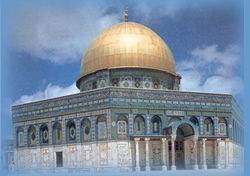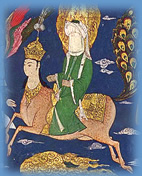 |
 |
Dome
of the Rock Jerusalem |
Muhammad’s
night journey 16th century Persian illustration |
Most glorified is the One who summoned His servant during the night, from the temple to the temple that is most remote, whose surroundings we have blessed, in order to show him some of our signs... (Qur’an 17:1)
The seventeenth sura of the Qur’an is known as “The Night Journey”, a reference to an ecstatic experience of the prophet Muhammad in which he felt himself transported to heaven. Lailat-ul-Mi’raj means “the night of ascent” and it is the name of the religious observance in honour of this experience.
The two temples mentioned in Sura 17 are believed to be Mecca and Jerusalem. According to tradition, the prophet made his ascent in the company of the Archangel Gabriel on a winged steed called al-Buraq (‘lightning’). Stopping briefly at Mt Sinai and Bethlehem, they finally alighted on the Temple Mount in Jerusalem where they encountered several other prophets including Abraham, Moses and Jesus. Gabriel then escorted Muhammad to the pinnacle of the rock, where a golden shaft of light beamed him into the presence of Allah: it was then that he received the instructions regarding salat, the daily Muslim prayers.
In the 7th century CE the 9th Muslim Caliph, Abd al-Malik, built the Dome of the Rock, the first great work of Islamic architecture. Besides its association with the Night Journey, the site in Jerusalem was also chosen for political reasons. For a brief period between 680 and 692, Mecca had become the capital of a rival caliphate, and the construction was undertaken in order to discourage pilgrimages to Mecca.*
On Lailat-ul-Mi’raj mosques and homes are festooned with lights and colourful banners. Believers mark the day with special prayers and public meetings, and it is considered an auspicious day to engage in charity and good deeds.